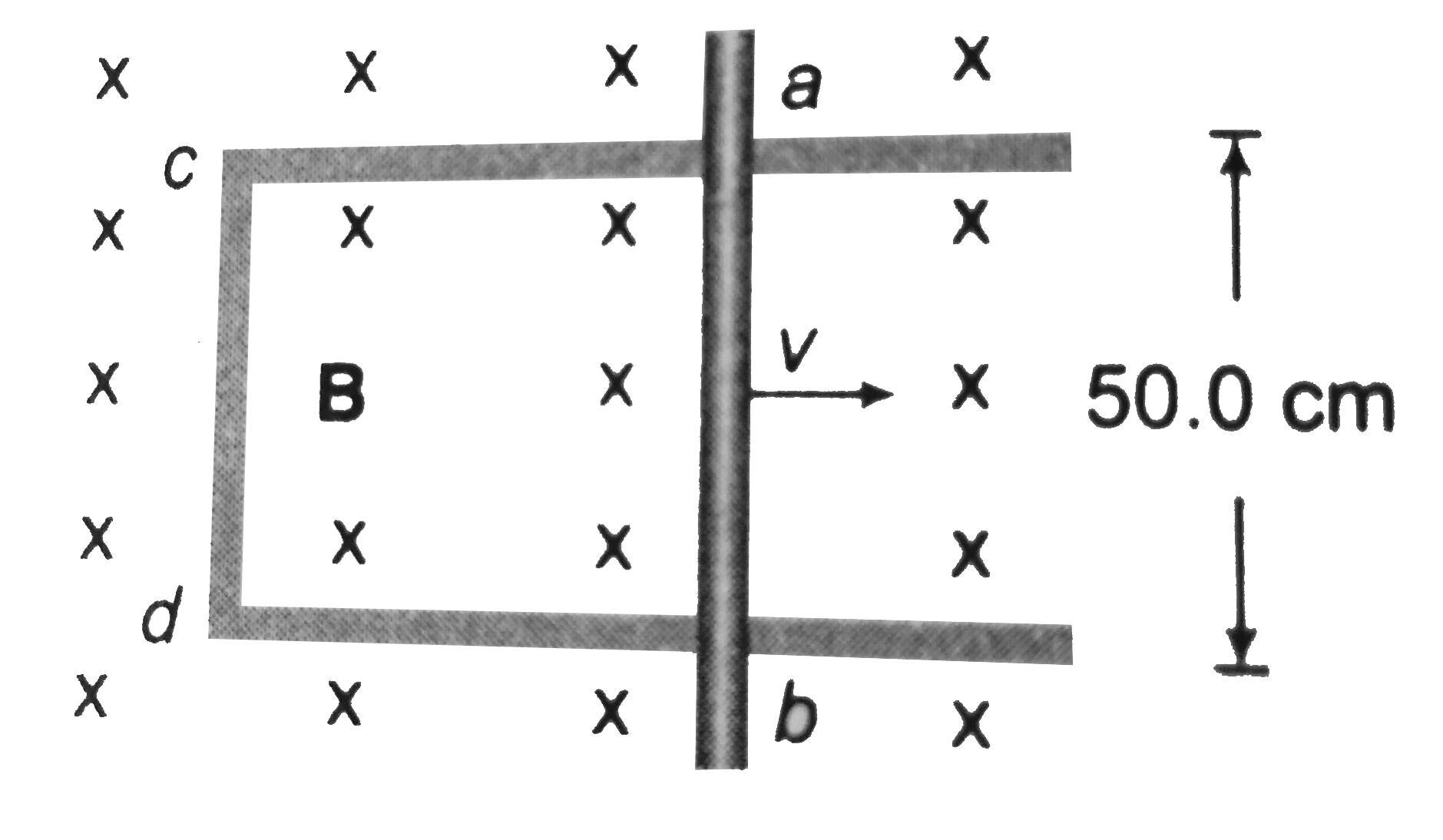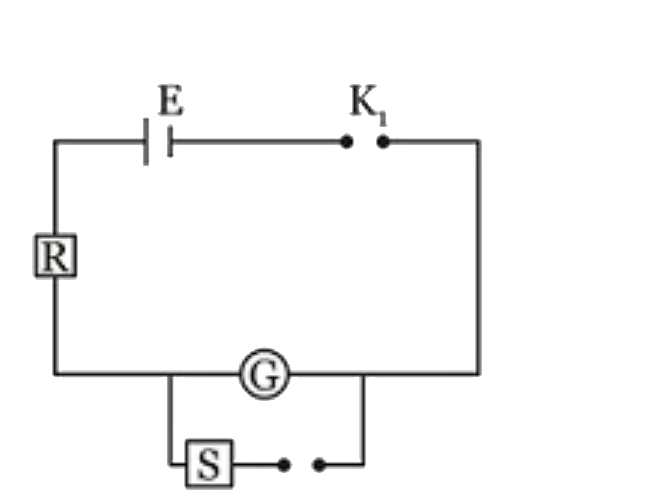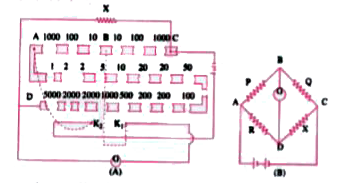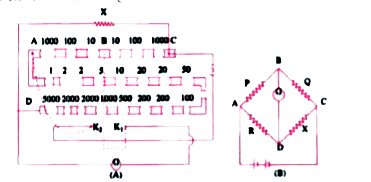In a certain experiment if QP=110 in R if 192Ω if used we are getting deflection toward right at 193Ω again toward rightr but at 194Ω deflection is toward left the unknown resistance should lie between .
19.2 to 19.3Ω
19.3 to 19.4Ω
19 to 20.3Ω
19.4 to 19.5Ω
The correct Answer is:B
To solve the problem, we need to analyze the given information step by step.
Step 1: Understand the relationship between the resistances
We are given that QP=110. This implies that the ratio of the unknown resistance Q to the known resistance P is 1:10.
Step 2: Use the known resistance R
We are given that R=192Ω. We will use this value to calculate the unknown resistance S based on the conditions provided.
Step 3: Calculate the unknown resistance S for the first case
When R=193Ω, the deflection is towards the right. We can use the relationship S=QP×R to find S:
S=110×193=19.3Ω
Step 4: Calculate the unknown resistance S for the second case
When R=194Ω, the deflection is towards the left. We will again use the same relationship:
S=110×194=19.4Ω
Step 5: Determine the range of the unknown resistance
From the calculations, we find that the unknown resistance S lies between:
19.3Ω<S<19.4Ω
Conclusion
Thus, the unknown resistance should lie between 19.3Ω and 19.4Ω.
We are given that QP=110. This implies that the ratio of the unknown resistance Q to the known resistance P is 1:10.
We are given that R=192Ω. We will use this value to calculate the unknown resistance S based on the conditions provided.
When R=193Ω, the deflection is towards the right. We can use the relationship S=QP×R to find S:
S=110×193=19.3Ω
When R=194Ω, the deflection is towards the left. We will again use the same relationship:
S=110×194=19.4Ω
From the calculations, we find that the unknown resistance S lies between:
19.3Ω<S<19.4Ω
Thus, the unknown resistance should lie between 19.3Ω and 19.4Ω.
Topper's Solved these Questions
- EXPERIMENTAL PHYSICSBOOK - RESONANCE ENGLISHCHAPTER - EXPERIMENTAL PHYSICSEXERCISE - Exercise
12 Videos
- EXPERIMENTAL PHYSICSBOOK - RESONANCE ENGLISHCHAPTER - EXPERIMENTAL PHYSICSEXERCISE - Exercise -1 PART
1 Video
- ELECTROSTATICSBOOK - RESONANCE ENGLISHCHAPTER - ELECTROSTATICSEXERCISE - HLP
40 Videos
- GEOMATRICAL OPTICS BOOK - RESONANCE ENGLISHCHAPTER - GEOMATRICAL OPTICS EXERCISE - Advance level Problems
35 Videos
Similar Questions
In post office box experiment, if QP=110. In (R ) if 142Ω is used then we get deflection towards right and if R=143Ω , then deflection is towards left. What is the range of unknown resistance?
View SolutionIn post office box experiment QP=110. In R if 142 Ω is used then we get deflection towards right and if R=143Ω, then deflection is towards left. What is the range of unknown resistance?
View SolutionAn electron is projectd horizontally with a kinetic energy of 10 keV. A magnetic feld of strength 1.0X10−7 T exists in the vertically upward direction. (a)will the electron deflect towards right or towards left of its motion? (b) calculate the sideways deflection of the electrion in travelling through 1m. make appropriate approximations.
View SolutionFind the value of i1/I2in figure if (a)R=0.1(Ω) (b)R=1(Ω)(c)R=10(Ω).Note from your answers that in order to get more current from a combination if two batteries they should be joined in parallel if the external resistance is small and in deries if the external resistance is large as compared to the internal resistances.

View SolutionAn ammeter is to be constructed which can read currents up to 2.0A. If the coil has a resistance of 25(Ω)and takes 1mA for full-scale deflection, what should be the resistance of the shunt used?
View SolutionThe conducting rod ab shown in figure makes contact with metal rails ca and db. The apparatus is in a uniform magnetic field 0.800T, perpendicular to the plane of the figure.

(a) Find the magnitude of the emf induced in the rod when it is moving toward the right with a speed 7.50m/s.
(b) In what direction does the current flow in the rod?
(c) If the resistance of the circuit abdc is 1.50Ω (assumed to be constant), find the force (magnitude and direction) required to keep the rod moving to the right with a constant speed of 7.50m/s. You can ignore friction.
(d) Compare the rate at which mechanical work is done by the force (Fu) with the rate at which thermal energy is developed in the circuit (I2R).
View SolutionIn an experiment to determine the resistance of a galvanometer by half deflection method, the circuit shown is used. In one set of readings , if R=10ΩS=4Ω, then the resistance of the galvanometer is

View SolutionIn meter bridge when P is kept in left gap, Q is kept in right gap, the balancing length is 40cm. If Q is shunted by 10Ω, the balance point shifts by 10cm. Resistance Q is
View SolutionPassage :
Post office is useful to measure the value of unknown resistance correctly upto 2nd decimal place. It is based on Wheatstone bridge.

Systematic diagrams of post office box are shown in the above figures. Each of the arms AB and BC contains three resistance of 10Ω,100Ωand1000Ω. These arms are generally known as ratio arms. With the help of these resistance, we can introduce resistance P in arm AB and Resistance Q in arm BC. The resistance arm AD is complete resistance box containing resistance from 1Ωto5000Ω. In this arm, we can introduced resistance R by taking out plugs of suitable values. The unknown resistance X is connected in fourth arm CD. These four arms actually form Wheatstone bridge shown in figure. For balanced conditions, no deflection is formed in galvanometer. At balanced condition PX=QR,X=QRP
While measuring surface tension of water using capillary rise method the necessary precaution to be taken is/are
View SolutionPassage :
Post office is useful to measure the value of unknown resistance correctly upto 2nd decimal place. It is based on Wheatstone bridge.

Systematic diagrams of post office box are shown in the above figures. Each of the arms AB and BC contains three resistance of 10Ω,100Ωand1000Ω. These arms are generally known as ratio arms. With the help of these resistance, we can introduce resistance P in arm AB and Resistance Q in arm BC. The resistance arm AD is complete resistance box containing resistance from 1Ωto5000Ω. In this arm, we can introduced resistance R by taking out plugs of suitable values. The unknown resistance X is connected in fourth arm CD. These four arms actually form Wheatstone bridge shown in figure. For balanced conditions, no deflection is formed in galvanometer. At balanced condition PX=QR,X=QRP
While measuring surface tension of water using capillary rise method, height of the lower meniscus from free surface of water is 3cm while inner radius of capillary tubne is found to be 0.5cm. Then compute surface tension of water using this data. [Take contact angle between glass and water as 0° and g=9.8ms−2 ]
View Solution